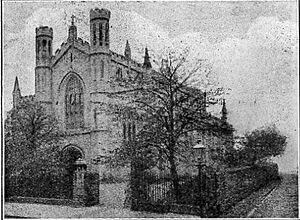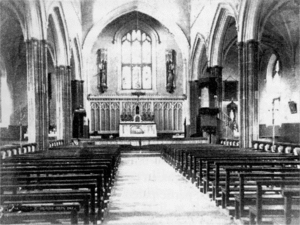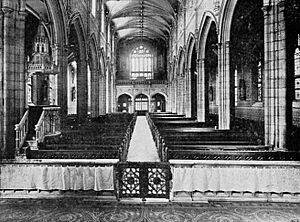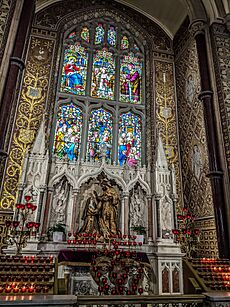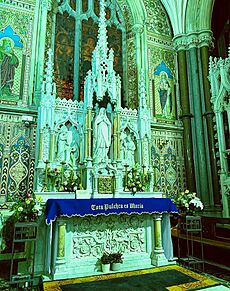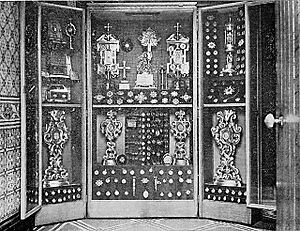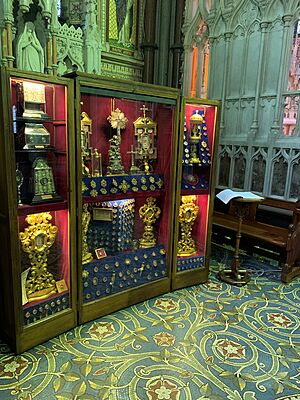Newry Cathedral facts for kids
Quick facts for kids Newry Cathedral |
|
|---|---|
| Cathedral of Saint Patrick and Saint Colman | |
 |
|
| Lua error in Module:Location_map at line 420: attempt to index field 'wikibase' (a nil value). | |
| Location | Newry, County Down |
| Country | United Kingdom Northern Ireland |
| Language(s) | English, Polish |
| Denomination | Roman Catholic |
| Tradition | Roman Rite |
| History | |
| Former name(s) | Saint Patrick's Cathedral |
| Founder(s) | Bishop Thomas O'Kelly |
| Dedicated | 6 May 1829 |
| Consecrated | 21 July 1925 |
| Relics held |
|
| Events | 150th Centenary - 21 July 1979 |
| Past bishop(s) | John McAreavey |
| Architecture | |
| Heritage designation | Grade A listed |
| Designated | 26 February 1976 |
| Architect(s) | Thomas Duff George Ashlin |
| Architectural type | Gothic Revival |
| Style | Gothic |
| Years built | 1825-1829, 1888-1890, 1904-1909 |
| Groundbreaking | 1825 |
| Completed | 1909 |
| Construction cost | £8,000 |
| Specifications | |
| Capacity | 1,000 |
| Nave length | 58 m (190 ft) |
| Nave width | 41 m (135 ft) |
| Nave height | 18 m (59 ft) |
| Number of towers | 1 |
| Tower height | 46 m (151 ft) |
| Materials | Newry Granite |
| Bells | 11 (Colman, Francis of Assisi) |
| Administration | |
| Parish | Newry Cathedral Parish |
| Archdiocese | Armagh |
| Metropolis | Armagh |
| Diocese | Dromore (since 6th Century) |
| Province | Armagh |
| Presbytery | Newry Parochial House, 38-40 Hill Street Newry |
The Cathedral of Saint Patrick and Saint Colman, also known as Newry Cathedral, is a Roman Catholic cathedral located in Newry, Northern Ireland. It is the main church for the Roman Catholic Diocese of Dromore and where the Bishop of Dromore has his official seat. Before the COVID-19 pandemic, more than 200,000 people visited the cathedral every year. This important building is on Newry's Main Street and is a Grade A listed building, meaning it's protected for its special history and architecture.
The cathedral replaced an older church called St Mary's, which was built in 1789. For 40 years, St Mary's served as both a local church and a temporary cathedral. Newry Cathedral, named after St Patrick and St Colman, was designed by a famous local architect named Thomas Duff. Building started in 1825, and the main structure was finished in 1829. It was built using local granite and was the first Catholic cathedral in Ireland to open after Catholic Emancipation, which gave Catholics more rights.
Over the years, more work was done to make the cathedral bigger and more beautiful. A tower and transepts (the parts that stick out on the sides) were added in 1888. The main part of the church, called the nave, was made longer in 1904.
Contents
History of Newry Cathedral
Early Beginnings
The Dromore area has had a bishop since the sixth century, thanks to Colman of Dromore. The old cathedral in Dromore was destroyed in 1641 and rebuilt later. In 1750, the main church for the diocese moved to Newry, which was the biggest town in County Down.
Finding the Perfect Spot in 1823
After he became Bishop, Thomas O'Kelly quickly started planning for a new cathedral. Records show that a meeting took place in 1821 to discuss building a new church in the town centre. A group of important Catholic citizens visited Lord Downshire to ask for land.
It took some time, but on September 20, 1823, a piece of land known as "Seymour's Green" was bought for the new church.
Laying the Foundation Stone
The foundation stone for the cathedral was laid by Bishop O'Kelly on June 8, 1825. Work continued under the next bishop, Dr. Thomas Kelly. The main building was finished in just four years.
The dedication ceremony happened on May 6, 1829. Many bishops and clergy attended, making it a very important event for the north of Ireland. People paid to attend the service to help cover the building costs. At first, the cathedral was known as the Cathedral Church of St. Patrick. Locally, people called it the "New Chapel."
Second Building Phase: 1888-1890
More construction work happened between 1888 and 1890. This was led by Bishop Thomas McGivern. The church needed to look more important, so Bishop Leahy started this second phase.
- In 1888, two transepts were added. The south transept was smaller because of a mill nearby.
- In 1890, the tall Great Bell Tower was finished, and a new sacristy (a room where priests prepare) was built.
- A new High Altar was put in the sanctuary in 1891.
- The bells for the tower were installed in 1898.
Third Building Phase: 1904-1909
The third major building phase took place from 1904 to 1909, under Bishop Henry O'Neill. Many believe his vision gave the cathedral its grand look today. The architectural firm Ashlin and Coleman from Dublin oversaw the work.
- The main part of the cathedral was extended by 40 feet towards Hill Street.
- The entire front of the cathedral was taken down and rebuilt exactly as it was, but further out.
- The sacristy was moved to its current spot.
- The new sanctuary was decorated with marble and beautiful carved screens.
- Five new stained glass windows were added around the sanctuary.
- The walls, floors, and side chapels were covered in colourful mosaics.
Even though there were money worries, enough funds came in to keep the work going smoothly. Money was raised by the local community and by priests who travelled to other parts of Ireland, England, Scotland, and the United States.
The mosaic work was done by Oppenheimer of Manchester. Newry Cathedral has the largest amount of gold leaf mosaic in Ireland. The mosaic pieces were put together on parchment strips and then applied to the walls like wallpaper.
A new organ and a new heating system were also installed during this time. Two years after this work, Bishop O'Neill bought the land south of the cathedral, where a mill once stood.
Becoming a Cathedral and Consecration
Even after all the building work, there was still a lot of debt. This debt was finally paid off in 1918 by Bishop Edward Mulhern. Although it was called a cathedral, it was officially a "pro-cathedral" (a church that serves as a cathedral but isn't formally one).
In 1919, the Pope officially made the church a full cathedral. At the same time, St. Colman's name was added to St. Patrick's as a joint patron saint.
With all debts cleared, Bishop Mulhern formally consecrated (blessed and dedicated) the building on July 21, 1925. This was exactly 100 years after its foundation stone was laid. The streets of Newry were decorated with flags and arches for the celebration. Many archbishops and bishops from around the world attended this special event.
Cathedral Features
The High Altar and Sanctuary
The High Altar is the largest shrine in the cathedral, standing 25 feet tall. It's made in a Gothic style with beautiful marble from different places like Sicily and Italy. The Tabernacle, which holds the Eucharist, has golden doors decorated with jewels. Sculptures of the Nativity (Jesus' birth) and Christ sending out the Apostles are carved into the marble. Two marble angels stand on either side of the altar.
The High Altar was built in 1894 to remember Bishop Pius Leahy. It cost about £3,700. Inside the Main Altar are relics (holy objects) of saints like Oliver Plunket and Columbanus.
The main sanctuary is a grand setting for the High Altar. The lower walls are covered in colourful marble, while the upper walls have gold and mosaic designs showing symbols and angels. Carved marble screens separate the main sanctuary from the two side chapels. The floor has a colourful mosaic design, including Bishop O'Neill's family crest. A silver sanctuary lamp hangs overhead.
The upper walls of the sanctuary have gold and blue mosaics that show objects related to Christ's Crucifixion, like the cross and chalice. The stained glass windows in the sanctuary show scenes from the life of Christ, his Apostles, and various saints. These windows were made by a company in Birmingham between 1908 and 1914.
Sacred Heart Shrine
This shrine is surrounded by marble altar rails. It was built to remember Fr. James Carlin. Above the altar is a golden shrine showing Christ revealing his Sacred Heart to Saint Margaret Mary.
The altar is made of Carrara marble with red, green, and yellow marble details. The stained glass window above the altar was originally in the main sanctuary. It shows scenes from the life of the Holy Family: Mary, Jesus, and Joseph at work.
On April 14, 1925, Bishop Edward Mulhern consecrated (blessed) the Sacred Heart Shrine. This was one of three altars blessed before the main cathedral consecration later that year.
Lady Chapel
The Chapel of the Blessed Virgin, also called the Lady Chapel, is to the left of the main sanctuary. It has beautiful marble and mosaic decorations. The walls around the altar show prayers to the Blessed Virgin Mary in gold mosaics. The altar itself is mostly Carrara marble with colourful columns. The tabernacle door is gold, and above it stands a marble statue of Our Lady of Lourdes. Two small marble panels show the Annunciation (when Mary was told she would have Jesus) and the Coronation of the Virgin.
The stained glass window above the altar shows the Virgin Mary with the Child Jesus. Her parents, St. Joachim and St. Anne, are shown in mosaics on either side. The sanctuary lamp in this chapel was a gift from the Children of Mary group in 1925. To the left of the altar, a stained glass window shows Christ blessing children.
Saint Joseph's Chapel
Saint Joseph's Chapel is to the right of the main sanctuary and has similar beautiful mosaics and marble work to the Lady Chapel. The altar is mainly Carrara marble with colourful columns. A gold door with red onyx columns encloses the tabernacle, and above it stands a marble statue of St. Joseph.
Marble panels show St. Joseph marrying the Virgin Mary and the Holy Family in their workshop in Nazareth. The wall also has prayers to St. Joseph in gold mosaics. The stained glass window above the altar shows St. Joseph and the infant Jesus. St. Patrick and St. Brigid appear in mosaics on either side. This chapel is often called the 'Holy Family Chapel' because its altar was a gift from the Holy Family Confraternity in 1908.
Cathedral Reliquary
The Cathedral Reliquary holds over 300 relics (holy objects) of saints. It has been called "Ireland's Most Precious Reliquary." This shrine is displayed for people to see each year during the week after All Saints' Day.
The collection includes:
- A piece of the True Cross (believed to be from the cross Jesus died on)
- A piece of the Veil of the Blessed Virgin Mary
- Pieces from the tools used in Christ's Passion
- Relics of the Apostles
- Relics of several Irish Saints, including St. Patrick, St. Brigid, and St. Oliver Plunket.
- Relics of many other Catholic Saints, including Popes, Martyrs, and Holy Women.
All these relics were collected by Bishop Mulhern, who also arranged the reliquary. The wooden case for the shrine was designed by Mr J.H. McAteer from Newry. Bishop Mulhern presented the reliquary to the Cathedral in 1925 when it was consecrated.
Cathedral Sacristy
The Cathedral has three sacristies (rooms where priests prepare for services). The "Boy's Sacristy" is for the altar servers, and the "Upper Sacristy" was for church groups. The most decorated one is the "Main Sacristy," also known as the "Canon's Sacristy."
This main sacristy has walls and ceiling covered in beautiful Austrian oak wood. It has special places for storage, a sink for holy water, and places for prayer. It's considered one of the finest examples of woodworking in the country.
On January 18, 1959, a fire badly damaged the Canon's sacristy. The heating system below caused the wooden floor to catch fire. The ceiling and part of the outer wall were destroyed. The fire service used water from the canal to put out the flames, which unfortunately dulled the marble. Luckily, the sacristy building is separate from the main church, so the damage was contained.
Mass was still celebrated that day, with temporary preparations. Felix O'Hare was hired to restore the sacristies. The fire changed the colour of the wood, making it a golden oak instead of its original darker shade. The difference can still be seen on the door frames. The cathedral still has a special set of vestments (clothes for priests) that smell of smoke from the fire.
Cathedral Organ
The organ is located above the main entrance at the back of the church. It was built by Messrs. Telford & Telford of Dublin in 1910. The people of the Diocese donated this organ after the cathedral was finished in 1909. Part of the cost was covered by grants.
In 1929, the organ was rebuilt and made electric. The pipes were moved to either side, which created more space in the gallery and allowed the large window at the front of the cathedral to be seen from inside. Because of this change, a lot of the mosaic work on the walls in the organ gallery is now hidden behind the organ.
Important Dates for the Diocese
- March 17: Feast Day of Saint Patrick, a patron saint of the Cathedral.
- June 7: Feast Day of Saint Colman, a patron saint of both the Diocese and the Cathedral.
- July 21: Anniversary of the Cathedral's Consecration.
- In 2029, the Cathedral will celebrate its 200th anniversary!
Cathedral Clergy
As of September 2022, the clergy serving Newry Cathedral include:
- Parish priest – Most Reverend Eamon Martin
- Administrator – Canon Francis Brown
- Curates – Fr Alphonsus Chukwunenye msp., Fr Wojciech Stachyra SChr., Fr Carlos Esteban Rojo
- Deacon – Rev. Francesco Campiello
Images for kids
-
Newry Cathedral Pieta
See also
 In Spanish: Catedral de San Patricio y San Colmán (Newry) para niños
In Spanish: Catedral de San Patricio y San Colmán (Newry) para niños


